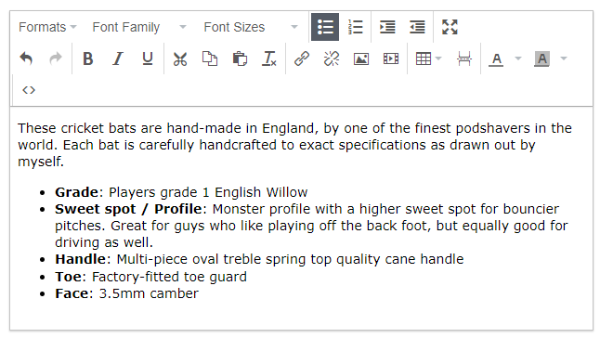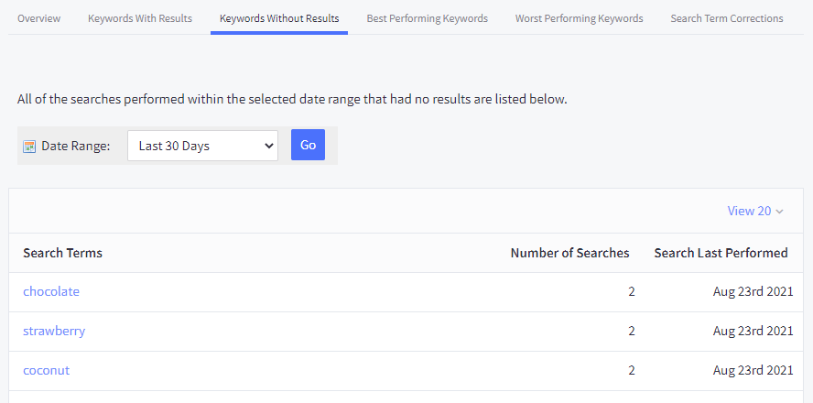Every BigCommerce store includes a built-in search that helps shoppers find the products, brands, categories, features, model numbers, and content that they care about.
On most themes, store search is located near the top of every page, in the header.

Looking for more help with SEO? See our Guide to SEO for comprehensive information and best practices to boost your search ranking.
Search Settings
Search settings can be accessed in Settings › Search.
- Default Product Sort — the order in which product search results display. In most cases, we recommend leaving this set to Relevance. Customers typically want the most relevant result based on what they were looking for. Select one of the following options:
- Relevance (Recommended)
- Featured Items
- Newest Items
- Bestselling
- Alphabetical: A to Z
- Alphabetical: Z to A
- Avg. Customer Review
- Price: Low to High
- Price: High to Low
- Default Content Sort — the order in which information and blog post (news item) results display. In most cases, we recommend leaving this set to Relevance. Select one of the following options:
- Relevance (Recommended)
- Alphabetical: A to Z
- Alphabetical: Z to A
- Search Logic — determines how the words in a search query are used to return results. Select one of two options:
- Only show results containing all words if a search contains multiple words — only shows results that include all words in the search query. For example, searching for "Red Shirt" will only return products with "Red" and "Shirt" in their searchable fields.
- Show results containing one or more words if a search contains multiple words — shows results that have at least one of the words in the search query. For example, searching for "Red Shirt" will return products with "Red" or "Shirt" in their searchable fields. This is the default setting.
Using a legacy Blueprint theme? There are additional options for managing search display in the Search tab. See Blueprint Themes for more information. For Stencil themes, these settings are managed in Page Builder.
Store Search Product Fields
Having accurate product details is not just a great way to optimize your store for search engines — it also ensures that customers can find the products they're looking for, once they're on your site.
Your store places priority on different product fields in the following order:
- SKU (exact match)
- Product Name (exact match)
- Brand Name
- Keywords (exact match)
- Product Name (partial match)
- Description
- SKU (partial match)
- Keywords (partial match)
This means that a customer searching your store for a SKU has a higher likelihood of having exactly the product they are looking for returned to them in the search results than if they search for a keyword.
SKU
SKUs are optional product identifiers which are either defined by the manufacturer of your products or by you as the store owner. If your customers are likely to know your product's SKUs, having this information entered for your products gives your customers an easy way to search for and find your products.
See Product Options (v3) for more information about adding SKUs to variants.
Product Name
Your product names should be relevant and something customers would search for. If your products have part numbers, avoid using only the part numbers for product names. Instead, give your products more descriptive names. For example, 123XYZ might get searched, but Widget Part Number 123XYZ is more helpful for customers who are not searching by or don't know the part number.
Brand Name
Many customers search by Brand, so make sure you list the brand name where appropriate, or even make it a part of your title if you think it's relevant enough.
See Managing Brands for more information on creating brands and applying them to products.

Product Description
Writing a good product description is not only a great way to inform your customers about your products and encourage them to buy, but it is also a factor in what they find while searching your site. If possible, include the following information:
- Dimensions and weight — exact sizes reduce shopper questions
- Materials or ingredients and care instructions — if the care instructions or ingredient list is long, consider uploading a picture as a secondary product image
- What’s included in the box — parts and accessories
- Warranty information and certifications
- Where the product was made

Search Keywords
Search keywords are additional search terms you enter to help customers find your products. They help to account for instances that can occur when customers are searching your store.
Enter search keywords for your products by adding or editing a product, then clicking on Storefront details in the side navigation.

Store Search Analytics
Keywords Without Results
The Keywords Without Results report provides you with a list of terms customers searched for that did not give them any results. To access this report, go to Analytics › In-Store Search, then click on the Keywords Without Results tab.

In the example image above, we see that customers who have searched for chocolate, strawberry, or coconut were shown a message saying their search did not match any products.
Using the methods described earlier, you can now add these keywords to any products you would like to show in the search results, should a customer happen to search for that term.
Worst Performing Keywords
The Worst Performing Keywords report provides you with a list of terms customers searched for that did return results. However, customers did not click on any of the products in the search results. To access this report, go to Analytics › In-Store Search, then click on the Worst Performing Keywords tab.
To get the most out of this report, you should review the keywords listed to provide you with an idea of what the customer was looking for when using that search term. Then, perform a search using that term to see which products are returned. You can then add that keyword to any products you would like to have included in the search results, when a customer searches for that term.
Search Term Corrections
The Search Term Corrections report provides you with a list of search terms which customers entered that caused them to receive a “Did you mean:” suggestion, which they then clicked. To access this report, go to Analytics › In-Store Search, then click on the Search Term Corrections tab.
Did you know? In order for suggestions to be made to your customers, Enable Search Suggest must be enabled from the Display tab in Settings › General.

In the example image above, we can see that a customer searched for "derss" and was shown the following message.

The customer then clicked the Refine Search link and was shown a product which matched that term. If appropriate, you can add "derss" as a keyword to any products you would like to have displayed in the search results if a customer searches for that term. Here are some other keyword terms that can be useful to include:
- Keywords that are being searched, but aren't included in your products' details
- Commonly misspelled products
- Specific part names or numbers
- Common variations of a search term, such as customers searching for Kleenex when you carry your own brand of tissues.
FAQ
Is widget content included in storefront search results?
No, text added to Page Builder widgets is not searchable.
Why are some products not searchable?
Confirm that the product is visible, not hidden by inventory settings, and is accessible to the Customer Group.
If a product is still not searchable, please contact our Support team for help.


